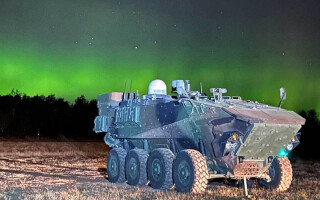Machine learning, deep learning networks support drone security in UND research project
StoryFebruary 12, 2019
A research team from the University of North Dakota (UND) has been working since mid-2017 under a grant from Rockwell Collins with the aim of addressing cybersecurity concerns involving unmanned aerial systems (UASs), more commonly called drones. The research, which is concluding in early 2019, has expanded to include a swarm of small-scale UASs, giving UND students real-world, hands-on experience using machine learning and neural networks to detect multiple targets in national airspace.
A research team from the has been working since mid-2017 under a grant from Rockwell Collins with the aim of addressing cybersecurity concerns involving unmanned aerial systems (UASs), more commonly called drones. The research, which is concluding in early 2019, has expanded to include a swarm of small-scale UASs, giving UND students real-world, hands-on experience using machine learning and neural networks to detect multiple targets in national airspace.
Dr. Prakash Ranganathan, Director of Cyber Security Programs at UND, is leading the Rockwell Collins-sponsored research project, which is titled “Geo-Fence Detection System (GFDS) for Unmanned Aerial Vehicular Airspace to provide Counter Autonomy.”
The growing use of UAS in national airspace requires continued research into security and advances in detection. While the commercial UAS market is not all that concerned with malicious cyberattackers, the military requires systems that to a certain extent are impossible to reverse-engineer. “Small scale UASs, or drones, are simply cyber-physical systems (CPS), which means there is a hardware and software component interplay to achieve a goal,” Ranganathan says. “The electronics and software applications embedded in these sUASs [small unmanned aerial systems] are vulnerable.”
It’s a fact that experienced malicious hackers can have a field day with the types of vulnerabilities to which drones are sensitive: “Vulnerabilities that a hacker can exploit include exploiting communication channels (radio frequency, Wi-Fi, Bluetooth) to access, transfer, and transport messages between one drone to another or to networks,” Ranganathan notes.
“In addition, GPS can also be spoofed to take control of these drones,” he continues. Ranganathan and researcher Eric Horton – in their coauthored article “Development of a GPS spoofing apparatus to attack a DJI Matrice 100 Quadcopter” – explain that “GPS spoofing is accomplished by a system capable of mimicking the GPS signals associated with every satellite in the GPS constellation visible to the target receive. The GPS transmission power of the fake GPS signals are higher than the real signals, resulting in the receiver locking onto them in favor of the true GPS. At this point the time shift of the fake signals can be manipulated to tamper with both the position and time reported by the receiver.”
The UND team dived into cutting-edge technologies such as machine learning to detect multiple targets. (Figure 1.) For example, “In the study, a Robot Operating System (ROS)-based swarm platform is utilized to simulate various communication and control architectures for conditions such as collision avoidance, path planning, and securing communications,” Ranganathan explains. “Large imagery data sets that contain nearly 20,000 images from multiple drone vendors were trained and tested using advanced machine learning and convolution neural network (CNN)-based algorithms to detect multiple target types in airspace. The research team is expected to test these approaches soon in a swarm of customized sUAS.”
Figure 1: UND Assistant Professor Prakash Ranganathan (right) with student researcher Eric Horton (left) holds a UAS used in the UND/Rockwell Collins research. Photo: UND/College of Engineering.
Although researchers, UAS developers, and students alike are using these cutting-edge technologies, they still face certain constraints. “Drone security technology must be robust in order to fit within the constraints of the drone’s limited size, weight, and power (SWaP),” Ranganathan says. “Security software and hardware cannot be too taxing in terms of weight and power consumption of the drones.”
In addition, he adds that we can longer rely on Wi-FI, radio frequency (RF), and Bluetooth technology when using UASs: These main lines of communication are no longer effective, which means that UAS “design considerations need to include a combination of, and switching between, cellular infrastructure and other communication modes.”
Because of these issues, ongoing research and development is paramount. Unfortunately, “Very little effort has gone into the security side of drones,” Ranganathan comments. “Literature is evolving on the deployment of encryption methods between the ground-control station, drone, and its data-storage units.”
The security challenges continue to mount when users seek to add additional drones to the mission or look to integrate emerging technologies, Ranganathan says. But those will be addressed, he says. “There’s a deepening understanding of how to ensure security when multiple drones are involved, and how security methods can use existing distributed computing methods such as blockchain or other encryption methods to offer a robust fault-tolerant sUAS.”







